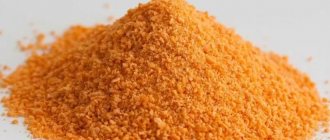What to look for when choosing?
To purchase a truly high-quality product, you need to take into account a number of features. Coconut oil comes in two types:
- unrefined - pure and natural, obtained from fresh pulp by quick drying;
- refined - heat-treated, obtained from pulp cake.
During refining, it loses most of its beneficial properties. However, such a product is stored for 1-2 years longer.
Unrefined is considered to be of higher quality. Suitable for both outdoor and indoor use.
It is also important to pay attention to other traits. Qualitative:
- quickly absorbed into the skin;
- does not leave a greasy film;
- has a sweetish aroma;
- has a light yellow or transparent tint in liquid form;
- frozen white;
- sweet to taste;
- melts in your mouth.
Thus, preference should be given to unrefined. It is considered completely natural because it has not been subjected to additional processing.
Storage conditions for coconut oil. What to look for
- The container in which coconut oil is stored must be clean. Anything that gets into a jar from the outside can become an excellent breeding ground for pathogenic organisms and bacteria.
- Coconut oil should be stored in tightly sealed jars and containers. In a sealed container, even high humidity will not harm the oil.
- Coconut oil should not be scooped with a wet spoon to prevent moisture from entering the jar.
- The spoon or knife for portioning coconut oil must be clean. Do not take the oil with your hands under any circumstances!
- If an unpleasant odor or sudden change in color occurs, the oil should be thrown away immediately.
What does safety depend on?
All products remain suitable for consumption for a certain period. The shelf life of coconut oil is directly affected by :
- type of product (storage duration depends on it);
- storage containers (dark glass containers should be preferred over plastic ones);
- environmental conditions (temperature, sun exposure, air access).
GOST 10766-64 “Coconut oil” does not provide any requirements regarding the shelf life of the product.
GOST only indicates the need to indicate the bottling date.
In such a situation, the manufacturer himself determines the expiration date of the product and indicates it on the packaging.
Most often, the shelf life ranges from 6 months (mainly for an unrefined product or edible oil) to 1 year (for a refined product).
On our market there is oil from India and Thailand , characterized by approximately the same shelf life.
Often tourists themselves bring coconut oil from Thailand. Such a product, as a rule, purchased from small family firms, is of questionable quality and is not stored for a long time; after a few months it may become unusable.
How to store an opened coconut
Soon the pulp begins to deteriorate and become bitter, and if the fruit is too cold, the pulp will become watery, which will also spoil its taste. So, if you want to enjoy coconut, choose fresh one from the store and eat it right away. And yet, how and where to properly store peeled coconut at home in order to maximize its shelf life?
Carefully open the nut. Pour the coconut milk into a suitable container. Take a glass jar or bottle, one that you can then tightly close with a lid. Strain the milk through cheesecloth or a fine strainer, pour into the prepared container, close the lid tightly and place in the refrigerator. A film similar to cream forms on its surface. It must be removed before use.
Storage conditions at home
Even the highest quality product can be spoiled if stored improperly. Therefore, it is necessary to create the right conditions in order to preserve the beneficial properties.
Storage container
Manufacturers do not always take into account the storage features of coconut oil and package it in transparent packaging. It is advisable to transfer the opened product to a dark glass jar. The coconut product deteriorates in light, and it is this packaging that provides protection.
It is also worth paying attention to the lid. It should close tightly.
Temperature and humidity
Coconut oil can be stored both in the refrigerator and indoors. In the first case, the temperature should be around +5-6°C. If it is stored in a room, you need to make sure that the temperature does not rise above +20°C. Heat and cold are contraindicated. Humidity should not be higher than 60%.
Lighting
One of the most important conditions for ensuring long-term preservation is the absence of light. Refers to sunlight, which has a particularly strong effect on product damage, and household lighting. In the light it quickly oxidizes, acquires a repulsive odor and a pungent taste. The rules are similar to the storage of draft beer.
Oxygen access
If you store coconut oil in loosely sealed containers, it will soon oxidize. It is recommended to use corks or glass lids as they provide greater protection.
However, the use of plastic lids is not excluded if they are screwed tightly.
Where is the best place to store
The shelf life will be longer if stored in the refrigerator. In this case, it will remain usable for a year.
If it is stored indoors, it usually loses its freshness within six months.
In what container should it be stored?
The main condition required for storage is suitable, correctly selected containers. It is advisable to give preference to glass, preferably dark in color, as less light enters through it.
When purchasing in liquid form, pour the product into a glass jar or bottle with a tight-fitting lid or stopper to prevent air from entering.
Should be stored only in dry, clean jars. To use part of the butter: cut off the entire piece using clean cutlery.
Store coconut oil at home correctly in a dark and dry place, in a cupboard or refrigerator. Permissible temperature range is from +5°C to 25°C. The best containers are dark glass jars.
After opening the package
After opening the sealed package, the product begins to be exposed to the destructive effects of the environment; water vapor, bright light, and air containing bacteria become dangerous for it.
Under what conditions should it be stored?
Until the peel is opened, fresh nuts are stored well in cool, dry places (pantries, kitchen cabinets) for about 30 days under the following conditions:
- temperature -+20°C;
- air humidity – 70%.
Storing a coconut for more than 1 month can cause the liquid inside it to turn sour and the copra (fruit pulp) to begin to dry out.
Storage table
| Whole nut storage temperature | Shelf life |
| 0 to +5 | 7-10 days |
| +5 and above | no more than a week |
| Stable temperature +5 | about a month |
Expiration dates
Most manufacturers indicate coconut oil has a shelf life of up to 2 years. Unrefined - up to 4 years.
Homemade coconut oil will keep in a dark glass container for about two weeks. The shelf life in ampoules after opening is about 12 hours.
Do not try to extend shelf life by storing in the freezer. If it is frozen, it loses its properties at very low temperatures.
Even after the expiration date, coconut oil can be used as a technical product - for example, for polishing furniture.
In the interstate standard of the Customs Union, which is GOST 10766-64 “Coconut oil”, there is no mention of the shelf life of the product. But the manufacturer is required to indicate the bottling date on the transport labeling. It is very important to pay attention! This will allow you to avoid purchasing a product of dubious origin and extend the time of use.
The longest period for products with added preservatives is several years, for refined oil - one year, for unrefined and refined oil intended for food consumption - six months. This is much less than, for example, when storing olive oil in an apartment.
In Russia, conditions for growing and processing coconuts are unsuitable; oils are supplied from other countries. Let's look at the main manufacturers.
From India
India is the largest supplier for Russia. The main imported volume of product is the result of industrial production, with a mandatory indication of the expiration date.
Here it is used in cooking, cosmetology and medicine, just like vegetable or sunflower oil in our country. Be sure to add it when making natural cosmetics (up to 10% of facial products, up to 30% of body products). An unrefined product is traditionally used for hair care. In Ayurveda, highly purified oil is used to combat various diseases.
Indian manufacturers:
- Saraswati cosmetics products have proven themselves well in cosmetology;
- Dabur Anmol use oil in hair products;
- Parachute produces products without deodorizing and bleaching, without using chemical additives, synthetic fragrances, or preservatives.
Coconut oil from India can be stored outside the refrigerator; at temperatures below +25° C it hardens and acquires a dense structure without losing its valuable properties. To return it back to the liquid state, you need to warm it up a little; a steam bath works well. It is better to store the product in the refrigerator at a temperature of +4° C. Depending on the processing method, shelf life varies. Mostly 6 months, rarely a year or several years.
From Thailand
Thailand exports coconut products. In addition to large productions, small family firms are popular. Despite the differences in technology, handicraft traditional, time-tested methods prevail over modern ones.
You should pay attention to the label - a beautifully designed one indicates quality control. Choose your product carefully. Oil from Thailand should not be dark or yellowish - a sign of poor purification. The present is transparent. When it freezes, it becomes white.
Thai manufacturers:
- Parisut Organic produces high-end products that meet all the criteria for excellent Thai coconut oil;
- Tropicana Oil uses the best varieties of coconut from the southern part of Thailand as raw materials.
Use in cooking
Many people know how to use coconut oil for cosmetic purposes, let’s look at how you can use it in cooking:
- coconut oil is used for preparing any hot dishes: meat, fish and vegetables, for soups, hot appetizers and sauces;
- Along with butter, coconut oil is suitable for side dishes: it can be added to mashed potatoes, pasta, rice or buckwheat porridge, and also used to dress salads;
- baked goods with coconut oil retain their fluffiness and freshness much longer;
- You can stew any vegetables in coconut oil and make a delicious stew;
- it is added to sweet milk porridges (for example, semolina, rice, millet or pumpkin);
- Coconut oil is ideal for deep-frying lovers - it does not go rancid, and therefore can be used in deep frying 5-7 times.
Good news for baking lovers: recent scientific research has revealed that coconut oil is not stored in fat, but is completely absorbed. In addition, consuming coconut oil during a diet can significantly reduce the carbohydrate content in the body.
Coconut oil is a real find. Check out its beneficial properties and include it in your diet. By following simple storage rules, you can preserve its unique qualities for a long time.
Features of storing capsules and ampoules
If coconut oil was purchased in capsules or ampoules, it is important to learn in advance how to store it at home. As a rule, capsules are sold in protective packaging, which is best preserved. It will protect the contents of transparent glass or plastic ampoules from direct sunlight.
To check whether the contents have deteriorated, you need to break one of them and squeeze out some liquid. It should show no signs of rancid oil and should be clear or slightly yellowish.
Important! It is advisable to use the opened capsule immediately and not store it for longer than 12 hours.
Capsules should be stored in a dark, cool place - a medicine cabinet or closet, and shortly before the expiration date - about three months - they should be hidden in the refrigerator.
Home cooking method
Making coconut oil at home is easy. Here is the algorithm of actions:
- Take a coconut and extract the pulp from it.
- Grate it.
- Squeeze the milk out of the resulting mass and place the liquid on low heat.
- A few minutes after the mass begins to boil, white clots of oil form, which must then be passed through cheesecloth.
The oily liquid is stored in glass bottles with tight (non-screw) stoppers. It is not advisable to store a natural product at room temperature. It is best to place it in the refrigerator or even in the freezer section.
You can use homemade oil for a short period of time, up to 14 days.
Homemade coconut oil is the best ingredient for hair masks and shampoos. It will not only help cope with problem skin, but also strengthen the immune system, improve hair condition and significantly reduce weight.
You need to study in detail the rules for storing a natural product, if they are available on the packaging. If there are none, then the oily substance is stored in a cool and dark place. If stored correctly and following all the tips, coconut oil can retain all its beneficial properties for quite a long period of time.
How to Store Different Types of Coconut Oil
Recipe for proper storage in order to preserve all the beneficial qualities and properties: keep in a cool, dry place, preferably in the refrigerator. The method is suitable for all types of products. Yeast dough must also be kept in the refrigerator.
Hot spin
Produced using the hot-press method (refined) has a weak aroma or no smell. Cleared of solid impurities, standard storage conditions - a cool place, preferably in a closet with tightly closed doors.
When in contact with oxygen, it oxidizes and quickly deteriorates. The expiration dates of the product indicated by the manufacturer on the packaging should be strictly observed. If you are poisoned by spoiled products and see the first signs of illness, consult a doctor immediately.
Cold pressed
Cold-pressed (unrefined) foods contain more micronutrients but spoil much more quickly than hot-pressed ones. Store in a glass container in a closet or nightstand.
Other
Oil prepared at home does not contain foreign impurities, but the shelf life of such a product is not long. It is stored under the same conditions as cold-pressed oil, but no more than 14 days .
Pharmacies often sell coconut oil in clear glass or plastic ampoules , as well as in portioned capsules . This product can be used for cosmetic and medicinal purposes. Like other species, it must be stored in a cool, dark place.
Housewives are often interested in the question of how to store coconut oil after opening . If you have a little product left in an open container, just pour it into an airtight container and ensure the storage conditions described above.
When storing the product, pay attention to the expiration date indicated on the packaging.
Capsules and ampoules with oil can be placed in the refrigerator shortly before the end date of use. This will extend its shelf life by at least several months.
If you doubt the freshness of the product, open one capsule, squeeze out a few drops of liquid from it and evaluate its condition by external signs. Only after making sure of the quality can you put the product in a cold place and count on the benefits from further use.
Coconut oil can be used to easily remove makeup from your skin or add a unique taste to baked goods, so a rational solution would be to always have a jar of the aromatic product on hand. We hope that our tips will help you with this.
What to do with delays
A number of signs indicate that the oil has gone bad:
- Severe yellowing. Normally, coconut oil can be golden or with a barely noticeable yellowish tint (this is typical for unrefined oils). A pronounced yellow color is a sign that the expiration date has expired; there is no point in storing it any further;
- Uncharacteristic smell. Unrefined oil should smell like coconut flesh. If any other smell comes from the jar, especially smoked meat or sausage, the oil is spoiled.
- Unpleasant, bitter taste. Normally, the taste of coconut oil is unobtrusive, sweetish, with the aroma of nut pulp. A musty taste and bitterness indicate that the shelf life has expired.
Many people wonder what to do with such oil and whether it can somehow be revived after its expiration date. It's a shame to throw it away, it's a waste of money. There are many articles on the Internet on the topic that expired milk can be used as a face and body cream, hair balm, and exfoliating masks for dead skin particles. It all depends on how much the permissible shelf life at home is exceeded and what condition the oil is in. If the delay is insignificant, the substance does not have a noticeable bitter taste or smell, it can be used to soften the keratinized skin of the feet. The product copes well with this function at any stage. But if it already smells, it’s better not to experiment with such oils, but to throw it away immediately. Any use of it at home is useless and simply unpleasant.
The question of how to properly store coconut oil is not difficult; rather, it is important to observe the subtleties of storage. The expiration date is not a marketing ploy, and it is no coincidence that doctors recommend getting rid of expired ones: such products have begun the process of decay and they will not bring any benefit. If it is clear from the consistency and smell that the coconut oil has expired, it is better to get rid of it immediately. Such a substrate should absolutely not be added to food; it will not help as a cosmetic product either, it will not nourish the hair with strength, but will simply make it greasy. The only thing you can get from such products is clogged pores, dull, quickly oily hair and a greasy shine to the skin.
Choosing a coconut
When choosing an exotic nut, first of all pay attention to its appearance - the shell must be intact, without cracks, dents or other damage.
Important. Buy only ripe fruit - coconut does not ripen during storage.
The ripeness of the fruit is determined by the following characteristics:
- a mature coconut has a dark brown rind and a rough, hairy surface;
- on one of its sides there are three dots darker in color than the entire fruit;
- the surface that surrounds these points is solid;
- There should be no stains, mold or signs of moisture on the peel.
To determine whether the nut is overripe, shake it - there will be a characteristic noise inside from a splash of coconut milk, and the fruit itself will be weighty. If you can’t hear the splashing and the coconut is light, this is a sure sign that it is overripe and dry.
How to tell if coconut oil has gone bad
It is very easy to determine the safety and suitability of oil for consumption: you need to pay attention to the appearance and smell.
If the liquid has acquired a whitish tint or a moldy film is clearly visible , the product is spoiled. It cannot be used in this case.
If the oil is stored at temperatures close to zero degrees and has a thick consistency, then the aroma becomes a guideline for determining spoilage.
An unpleasant musty or rancid smell indicates spoilage and is a bad sign.
Such a product must be thrown away, since it is almost impossible for a non-specialist to determine the degree of spoilage, but you can easily harm yourself by using a spoiled product.
Storage conditions
The correct way to store a coconut with its whole husk is in a dry and cool place - a pantry or kitchen cabinet will do. The optimal temperature is no higher than +20°C, and humidity no more than 70%. Under these conditions, the coconut will remain fresh for 30 days.
Advice. It is not recommended to eat fruit whose shelf life exceeds 30 days, even if all storage conditions are met. The coconut water will spoil and become sour and the flesh will be dry. Eating stale coconut can cause stomach upset.
In a refrigerator
The ideal place for coconut is in the refrigerator. When purchasing, pay attention to where the fruit lies. The ideal storage location is a refrigerator.
How long can coconut be stored in the cold? If you leave it on the refrigerator shelf, you can eat it after three months.
Important. Pay attention to the label that is on the coconut. It contains all the information about a particular fruit, the name of the supplier and tips for storing it at home.
Find free space in the refrigerator for an exotic fruit and do not leave it next to apples, pears or bananas. They produce ethylene, which speeds up the ripening of the fruit, which leads to spoilage of the coconut.
Opened coconut
Once the coconut is opened, the only suitable place to store it is in the refrigerator. Store opened coconut at +5°C and 70% humidity. In these conditions it will remain fresh for two days.
Advice. Pour the coconut water into a separate glass container and close it tightly. If you do not do this, the water will turn sour and become unsuitable for consumption. In a tightly sealed bottle it will keep for seven days.
Wrap the coconut in cling film - its flesh will not oxidize when exposed to oxygen and will remain fresh longer.
Coconut pulp
The pulp of an exotic fruit, once opened, will not remain fresh for long. Carefully separate it from the shell, place it in a suitable container and cover tightly with cling film. On the refrigerated shelf at a temperature of +5°C, the pulp remains fresh throughout the day.
Interesting fact. Unusual interior items are made from coconut shells. It is often used to make dishes that look original and attractive.
If you need to preserve the pulp for several months, a freezer will help with this. Carefully separate the pulp from the shell, grind in a blender, sprinkle with coconut water, place in portions in freezer bags and place in the freezer compartment.
Advice. Do not try to grind the pulp with a grater, it is hard and you will spend a lot of extra time and effort on this process.
Coconut pulp can be stored in the freezer for up to six months. Do not defrost it before cooking, otherwise it will become watery and tasteless.
coconut flakes
To keep coconut flakes fresh for a long time, place them in an airtight bag and store them in a dry, dark place. Do not leave it near products that have strong, pungent odors - the shavings have the property of absorbing them. It remains fresh and edible for no more than a month.
Coconut milk
Even if you leave opened coconut milk in the refrigerator, it will not stay fresh for more than a day. If you buy milk in a store, in a special sealed package and follow all storage recommendations indicated on the package, the shelf life increases to 12 months.
After opening a package of store-bought coconut milk, consume it within 48 minutes. If you are not going to use the entire package right away, pour the remainder into a glass glass, close tightly and put it in the refrigerator.
Important. Cream gradually forms in a glass of milk - this is not a sign of spoilage, but a feature of coconut milk.
Can coconut milk be frozen for storage? Coconut milk is fatty and is not recommended to be frozen. After defrosting, it will separate, become watery and lose its unique taste and beneficial properties.
How to make and store coconut flakes
To increase the shelf life of the nut, it can be dried. To prepare the shavings you should use the following methods:
- Open the nut and drain the liquid from it. Divide the fruit into fragments and remove the peel. Grind the peeled pulp using a blender and place on a baking sheet. Dry in the sun or near a radiator. This usually takes 2 days.
- To dry the nut pulp in the oven, place it on a baking sheet lined with parchment paper. The oven should be heated to 120 degrees, turn it off and place the pulp inside. Check the chips as they cool. If it remains wet, heat the oven to 50 degrees and leave the mixture for 30 minutes.
- The easiest way is to use a microwave. It is recommended to place the shavings on a glass tray and place them in the device for half an hour, turning on the defrosting mode. Then open the door and hold the chips for 10 minutes. The manipulation should be performed until the pulp dries.
To preserve the properties of coconut flakes for a long period of time, they should be stored in a dry and dark place.
It is important to keep dry pulp away from foods that have a strong aroma
Before preparing the dish, you need to measure out the required amount of dry coconut in advance and transfer it to a separate container. It is worth considering that keeping this product in the refrigerator is not recommended. With this method, condensation appears on the surface of the chips. Subsequently, this becomes the cause of rot and mold.









